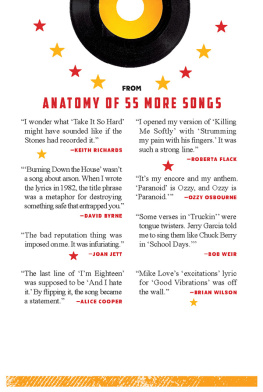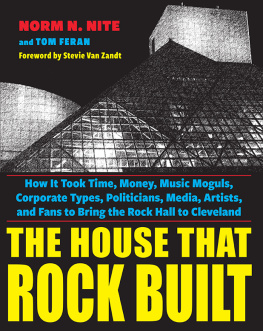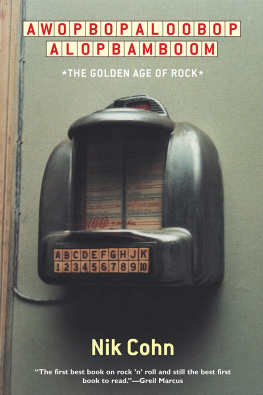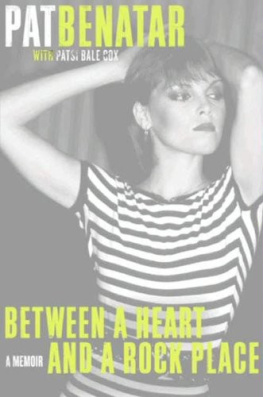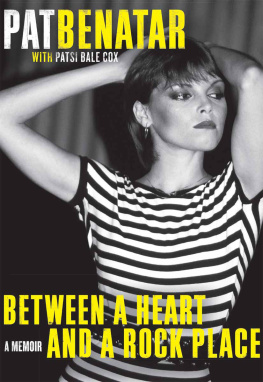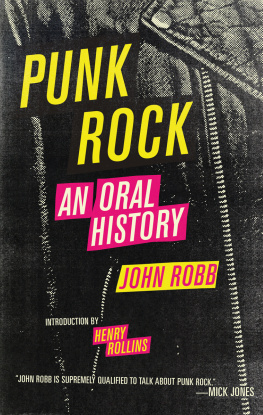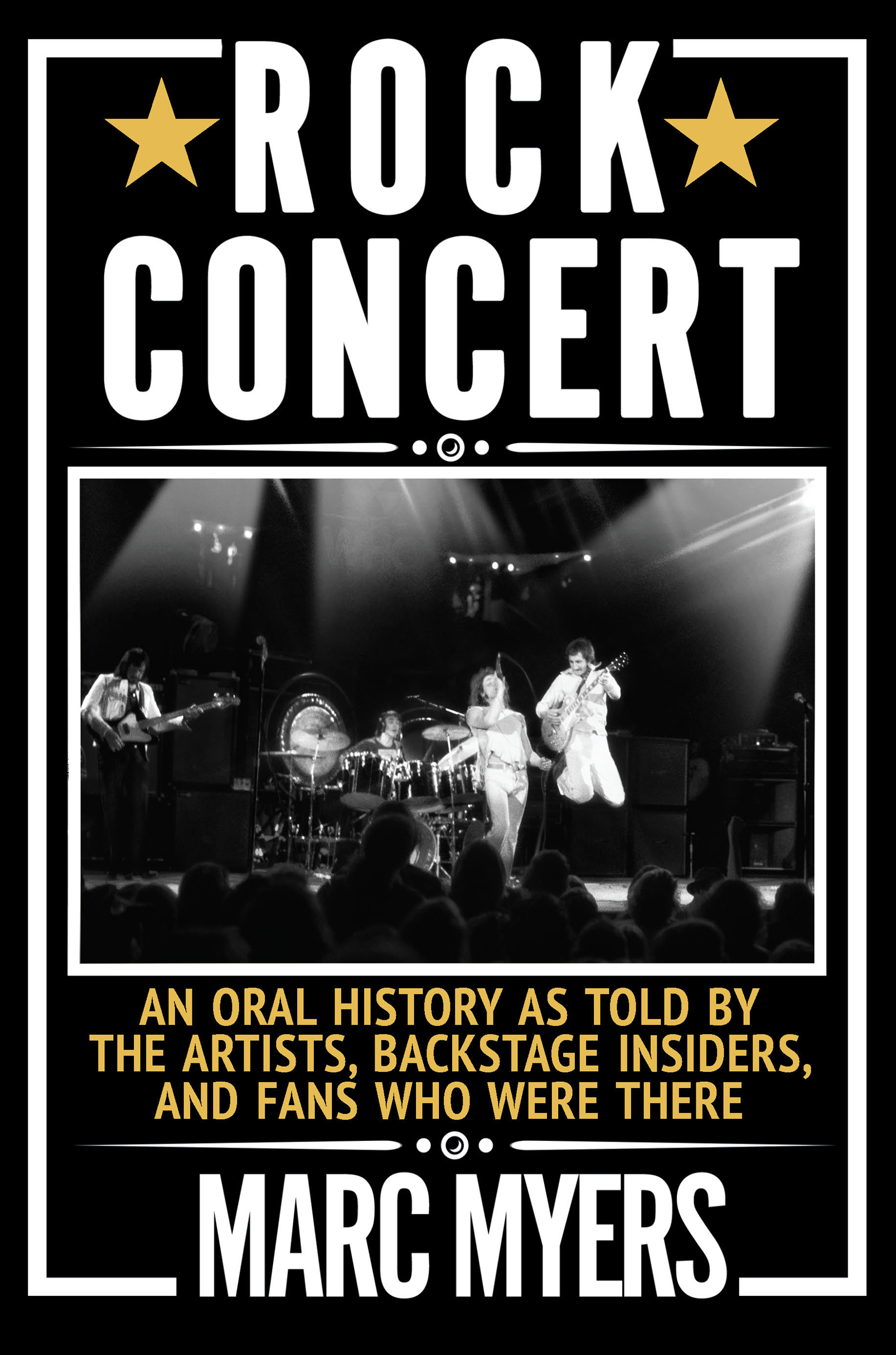Contents
Guide
Pagebreaks of the print version
Also by Marc Myers
Anatomy of a Song
Why Jazz Happened
ROCK CONCERT
AN ORAL HISTORY AS TOLD BY THE ARTISTS, BACKSTAGE INSIDERS, AND FANS WHO WERE THERE
MARC MYERS

Grove Press
New York
Copyright 2021 by Marc Myers
Jacket design by Rich Herrera
Jacket photograph: The Who, in Atlanta, GA, 1973
Bob Gruen (bobgruen.com)
Photo credits are as follows: (Frank Barsalona): Courtesy of D GORTON/The New York Times/
Redux. Photo : Evening Standard.
All rights reserved. No part of this book may be reproduced in any form or by any electronic or mechanical means, including information storage and retrieval systems, without permission in writing from the publisher, except by a reviewer, who may quote brief passages in a review. Scanning, uploading, and electronic distribution of this book or the facilitation of such without the permission of the publisher is prohibited. Please purchase only authorized electronic editions, and do not participate in or encourage electronic piracy of copyrighted materials. Your support of the authors rights is appreciated. Any member of educational institutions wishing to photocopy part or all of the work for classroom use, or anthology, should send inquiries to Grove Atlantic, 154 West 14th Street, New York, NY 10011 or .
Published simultaneously in Canada
This book was designed by Norman E. Tuttle at Alpha Design & Composition.
This book was set in 11-pt. Goudy Oldstyle by Alpha Design & Composition of Pittsfield, NH.
First Grove Atlantic edition: November 2021
Library of Congress Cataloging-in-Publication data is available for this title.
ISBN 978-0-8021-5791-1
eISBN 978-0-8021-5793-5
Grove Press
an imprint of Grove Atlantic
154 West 14th Street
New York, NY 10011
Distributed by Publishers Group West
groveatlantic.com
To Alyse, Olivia, and Dylan,
my rock stars
CONTENTS
INTRODUCTION
Live music has a long past. The Hurrian songsone of the worlds oldest examples of written music, composed 3,400 years agowere meant to be performed in front of an audience. Scratched onto clay tablets, the ancient songbook was unearthed by archeologists in the 1950s at the entrance to a royal palace in Syria. The tablets even included tuning instructions for a Babylonian lyre, an early stringed relative of the guitar. Though many of the songs survived only in fragments, the one complete tablet was a hymn to Nikkal, the Hurrian goddess of orchards and wife of the moon god. Love songs and concerts werent far behind.
From the beginning, live musics purpose was to transform a gathering into a community by unifying an audiences mood. Live music could accomplish what oratory often failed to achievecollective agreement and a sense of belonging. Through the centuries, live performances that had once been held only at palaces, churches, and the homes of the wealthy expanded to public spaces. The arrival of printed sheet music in America in the mid-1800s and wax phonograph cylinders in 1889 gave rise to popular music and at-home entertainment, but they didnt replace live music. In fact, the proliferation of parlor pianos and recorded music boosted the publics interest in performance. At the start of the twentieth century, live music not only was a diversion but also helped assimilate millions of newly arrived immigrants by making them feel American.
The first rock concerts went one step further. For the first time, a genre of popular music was recorded and performed specifically for adolescent listeners. In addition to uniting this market, the music empowered the youth culture to air its grievances and stand up for its rights. Throughout the first half of the twentieth century, traditional popular music certainly attracted teens, but they were listening to their parents music. What changed in the mid-1950s was access and allowance money.
Starting in the early 1950s, sales of portable phonographs for teens and preteens began to climb. Parents were happy to shell out for light-weight record players, since the turntables and 45s kept children at home in their rooms and allowed parents to watch their new TV sets undisturbed. Smaller night-table radios also wound up in childrens rooms, giving them an opportunity to find new music anywhere on the dial. But as parents soon discovered, the music teens found was provocative and liberating.
From the start, rock n roll artists, records, and concerts sided with teens in their battle for independence from parents. Over time, the music would support a wide range of teen grievances. Between 1950 and 1985, rock echoed the American youth cultures concerns with segregation, lousy teachers, the threat of nuclear war, middle-class conformity, the draft, the Vietnam War, civil rights, womens rights, pollution, gay rights, world hunger, imperiled family farms, and more. Through rock, the youth culture had a voice.
Rocks roots date back to 1944 and the emergence of hundreds of independent record labels. A good number of these labels recorded Black artists pioneering a new form of saxophone-driven dance music known broadly as jump blues. This extension of boogie-woogie led directly to R&B in 1949, which relied on smaller ensembles, vocals, and a distinct backbeat. By then, the use of tape in studios reduced the cost of recording and enabled a greater number of small labels to record R&B artists. Unlike pop and jazz, R&B exhibited a new level of earthiness and blunt sexuality, and R&B concerts added visual excitement.
In the mid-1950s, the music shifted and a new, gentler form of R&B was marketed to teens. Instead of dwelling on sex, drinking, cheating, and other adult themes that dominated R&B records, rock n roll concerned itself with teen anxieties and social issues such as cars, school life, dances, dating, breaking up, and falling in love. Uplifted by animated disk jockeys who played rock n roll records and championed the youth culture on the radio, teens embraced the music and concerts as a way to bond socially and rebel against the restrictions imposed by authority figures. They also began to question and challenge adult values.
Before the arrival of rock n roll, popular music made little effort to win over young listeners. One of the first significant pop concerts was Paul Whitemans An Experiment in Modern Music at New Yorks Aeolian Hall in February 1924. The concert was notable for the debut of George Gershwins Rhapsody in Blue, a classical-jazz suite commissioned exclusively for the event. Whitemans intent was to show that American jazz in the hands of a Broadway songwriter could impress a highbrow audience weaned on European classical music. The paying audience was composed mostly of adults.
Louis Armstrongs lyrical and bold trumpet playing during performances with the Fletcher Henderson Orchestra in the 1920s and in his own Hot Five and Hot Seven ensembles helped jazzs raucousness and dance steps connect with young adult audiences. Armstrong also helped establish the electrifying improvised solo. Bix Beiderbeckes horn did the same with college-age audiences in the 1920s. Throughout the decade, jazz was so potent that the syncopated music left its mark not only on young adults but also on everything from fashion and design to architecture and the English language. Theres a reason the 1920s was known as the Jazz Age.


